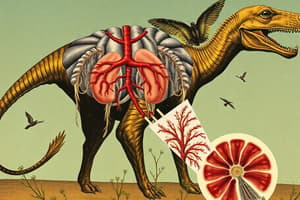Podcast
Questions and Answers
Which characteristic is NOT associated with cyclostomes?
Which characteristic is NOT associated with cyclostomes?
- A muscular tongue with keratinous teeth
- Rudimentary vertebral precursors
- The presence of a jaw (correct)
- A single nostril
What unique feature do hagfish possess that assists them in their scavenger lifestyle?
What unique feature do hagfish possess that assists them in their scavenger lifestyle?
- A protrusible jaw with sharp teeth
- A complex, multi-chambered heart
- Multiple slime glands (correct)
- Paired fins for propulsion
How do adult lampreys typically obtain their nutrition, differing from their larval stage?
How do adult lampreys typically obtain their nutrition, differing from their larval stage?
- Photosynthesis
- Scavenging dead organisms
- Parasitizing other fish (correct)
- Filter feeding
What is the term for the larval stage of lampreys?
What is the term for the larval stage of lampreys?
During their spawning cycle, adult lampreys that migrate from lakes and oceans utilize which type of behavior?
During their spawning cycle, adult lampreys that migrate from lakes and oceans utilize which type of behavior?
How do larval lampreys facilitate the movement of water over their gills?
How do larval lampreys facilitate the movement of water over their gills?
What is the typical ratio of female to male hagfish?
What is the typical ratio of female to male hagfish?
Which of the following describes the location of the mouth on an adult lamprey?
Which of the following describes the location of the mouth on an adult lamprey?
Which geological period is NOT considered part of the 'Age of the Fishes'?
Which geological period is NOT considered part of the 'Age of the Fishes'?
What feature does Pikaia possess that places it within the clade Chordata?
What feature does Pikaia possess that places it within the clade Chordata?
Which of the following is NOT a synapomorphy of Haikouella?
Which of the following is NOT a synapomorphy of Haikouella?
What discovery helped scientists determine that Conodonts were members of the clade Vertebrata?
What discovery helped scientists determine that Conodonts were members of the clade Vertebrata?
What is one piece of evidence supporting the hypothesis that vertebrates originated in a marine environment?
What is one piece of evidence supporting the hypothesis that vertebrates originated in a marine environment?
What distinguishes the Quaternary period from other periods in the fossil record?
What distinguishes the Quaternary period from other periods in the fossil record?
Which of the following best describes the transition between the 'Age of the Dinosaurs' and the rise of mammals?
Which of the following best describes the transition between the 'Age of the Dinosaurs' and the rise of mammals?
Which feature of Hagfishes provides evidence of the original vertebrate condition in terms of body fluids?
Which feature of Hagfishes provides evidence of the original vertebrate condition in terms of body fluids?
What factor initially prevented sea lampreys from entering Lake Erie?
What factor initially prevented sea lampreys from entering Lake Erie?
What was the consequence of lamprey invasion in the Great Lakes prior to control measures?
What was the consequence of lamprey invasion in the Great Lakes prior to control measures?
What characteristic is shared by ostracoderms?
What characteristic is shared by ostracoderms?
What major evolutionary development is associated with the Gnathostomata?
What major evolutionary development is associated with the Gnathostomata?
Which of the following best describes the function of the conus arteriosus found in Gnathostome hearts?
Which of the following best describes the function of the conus arteriosus found in Gnathostome hearts?
In mammals, how are teeth attached to the jaw?
In mammals, how are teeth attached to the jaw?
What is the evolutionary source of gnathostome jaws?
What is the evolutionary source of gnathostome jaws?
What major genetic event allowed the development of jaws in animals?
What major genetic event allowed the development of jaws in animals?
Flashcards
Geologic Period
Geologic Period
A period of time in Earth's history characterized by significant changes in landmasses, organisms, or events like asteroid impacts.
Paleontology
Paleontology
The study of fossils to understand the history of life on Earth.
Clade
Clade
A group of organisms that share a common ancestor and certain distinguishing characteristics.
Notochord
Notochord
Signup and view all the flashcards
Myomere
Myomere
Signup and view all the flashcards
Agnathans
Agnathans
Signup and view all the flashcards
Gnathostomes
Gnathostomes
Signup and view all the flashcards
Marine Origin Hypothesis
Marine Origin Hypothesis
Signup and view all the flashcards
Hagfish
Hagfish
Signup and view all the flashcards
Lamprey
Lamprey
Signup and view all the flashcards
Ammocoete
Ammocoete
Signup and view all the flashcards
Tidal Ventilation
Tidal Ventilation
Signup and view all the flashcards
Anadromous
Anadromous
Signup and view all the flashcards
Filter Feeding
Filter Feeding
Signup and view all the flashcards
Metamorphosis
Metamorphosis
Signup and view all the flashcards
Ostracoderms
Ostracoderms
Signup and view all the flashcards
Gnathostomata
Gnathostomata
Signup and view all the flashcards
Origin of Jaws
Origin of Jaws
Signup and view all the flashcards
Cyclostomes
Cyclostomes
Signup and view all the flashcards
Evolution of Jaws
Evolution of Jaws
Signup and view all the flashcards
Gnathostome Derived Characters
Gnathostome Derived Characters
Signup and view all the flashcards
Gnathostomes Teeth
Gnathostomes Teeth
Signup and view all the flashcards
Study Notes
Agnathans and Gnathostomes
- Agnathans are jawless fish, including hagfish and lampreys
- Gnathostomes are jawed fishes
- Gnathostomes evolved from Agnathans
- Differences between the two groups include the presence of jaws in Gnathostomes
Geologic Time and the Fossil Record
- Earth formed over many years
- Periods/epochs are distinguished by changes in landmasses, organisms, or asteroid impacts
- "-zoic" means "animal," referring to the appearance of animal life after Precambrian
- Ordovician, Silurian, and Devonian periods are known as the "Age of the Fishes"
- Permian, Triassic, Jurassic, and Cretaceous periods are known as the "Age of the Dinosaurs"
- Tertiary period marked the start of mammals
- Quaternary period marks the appearance of the genus Homo - Pleistocene era is the caveman era
- Holocene era is the modern human era
What Did the Earliest Vertebrates Look Like?
- Pikaia, from the Burgess Shale beds in British Columbia, was an invertebrate chordate
- It possessed a notochord and V-shaped myomeres, placing it in the Chordata clade
- Possibly a cephalochordate
Early Vertebrate Evidence
- Haikouella, a small fish-like animal from early Cambrian beds in Haikou, China, displayed chordate synapomorphies (dorsal nerve cord, notochord, pharynx)
- It also exhibited vertebrate synapomorphies (pharyngeal muscles, paired eyes, enlarged brain)
- However, Haikouella lacked a cranium and a distinct forebrain, suggesting it is not a vertebrate, but possibly a sister group
Conodonts
- Conodonts were odd tooth-like fossils discovered in Paleozoic marine sediments
- Fossils in the 1980's showed myomeres, teeth, paired eyes, notochord
- These are almost certainly members of the clade Vertebrata, though their exact position remains uncertain
Environment of Early Vertebrate Evolution
- Earliest fossils were found in marine sediments
- Nonvertebrate chordates and deuterostome invertebrates originated in the marine environment, displaying body fluid concentrations similar to their surroundings
- Hagfishes also show these characteristics
Simplified Phylogeny of Early Vertebrates
- Phylogeny diagram showing extinct and extant jawless (Agnatha) and jawed (Gnathostomes) vertebrate groups
- Extinct groups are indicated with + signs
Cyclostomes - Extant Jawless Fish
- Agnatha (jawless) include hagfish and lampreys
- Lack of internal ossification, paired fins, scales, and jaws
- Lack complex reproductive structures
- Single nostril
- Have a velum (pump)-pharynx
- Have rudimentary vertebral precursors (arcualia)
- Single circulation
- Muscular tongue with keratinous teeth
Myxiniformes - Hagfishes
- ~75 species, ~0.5m long marine cold water scavengers
- Slime glands (90-200)
- Single opening for water intake (olfaction and gill ventilation)
- Gill openings moved posteriorly (burying head in prey)
- 5-16 pairs of gill openings
- Females outnumber males 100:1
Petromyzontida - Lampreys
- ~40 species, both freshwater and marine, free-living and parasitic
- 10 cm to 1 m in length
- Temperate waters
Lamprey Spawning Cycle
- Adults migrate from lakes or oceans to small streams in late winter/spring
- Build nests, eggs hatch in ~2 weeks, releasing ammocoetes (larval stage)
- Ammocoetes filter feed and remain in the larval stage for 3-7 years
- Free-living lampreys don't feed as adults and die after spawning
- Parasitic species migrate back to lakes/oceans and live as parasites
Humans vs. Lampreys
- Sea lamprey (Petromyzon marinus) moved into Lake Ontario
- Niagara Falls used to be a barrier
- Construction of canals in 1913-1918 allowed the lamprey to enter Lake Erie and then spread
- Lamprey invasion resulted in a collapse of Lake Trout fisheries by 1950
- Control measures were implemented
Ostracoderms
- First unambiguous vertebrate fossils
- Jawless, possessing true bone
- Median fins (dorsal, anal, caudal)
- Heavy armor plating
Gnathostome Derived Characters
- Jaws and teeth, allowing for a firmer grip and increased food access
- Two sets of paired limbs (pectoral and pelvic), improving movement
- Jointed gill arches for double-pump ventilation
- Vertebral column with segmented vertebrae (protecting the spinal cord/ providing structural support)
- Nerve fibers possessing myelin sheaths to increase their efficiency
- Epaxial and hypaxial muscles enabling efficient movement
- Ribs connecting myomeres for more efficient locomotion
- Heart with additional parts, such as the conus arteriosus, improving circulation
Gnathostome Body Plan
- Horizontal septum divides trunk muscles
- Three semicircular canals in the inner ear
- Two olfactory tracts, leading to two nostrils
- Jaws with teeth
- Jointed gill arches
- Internal gill rakers preventing food from entering the gills
- Hypobranchial muscles connecting to the pectoral girdle
- Heart with conus arteriosus between ventricle and ventral aorta
Extant Gnathostome Teeth
- Differences in tooth structure (placement, and attachment style) across distinct vertebrate groups (e.g., chondrichthyans, bony fish, amphibians, reptiles, mammals)
Origin of Jaws
- Gnathostome jaws formed from the mandibular arch; the hyoid arch forming the jaw supports.
- HOX genes duplication event allowed complex jaw structures
Cyclostome vs. Gnathostome Gill Placement
- Cyclostomes have gills located internally, while Gnathostomes have gills in a more external position
Vertebrate Nose
- Cyclostomes have single nostrils (monorhiny)
- Gnathostomes have double nostrils (diplorhiny)
- Nasal capsules are close to the forebrain in cyclostomes, making it short; in Gnathostomes, the nasal capsules are more anterior, resulting in a longer brain.
Origin of Paired Appendages
- Pectoral fins were the first paired appendages
- Fish swim by flexing their bodies and tail in a wave motion with lateral fin movements
Advantages of Fins
- Caudal fin propels the fish through water
- Other fins (e.g., pectoral and pelvic) control direction and act as brakes
Studying That Suits You
Use AI to generate personalized quizzes and flashcards to suit your learning preferences.




